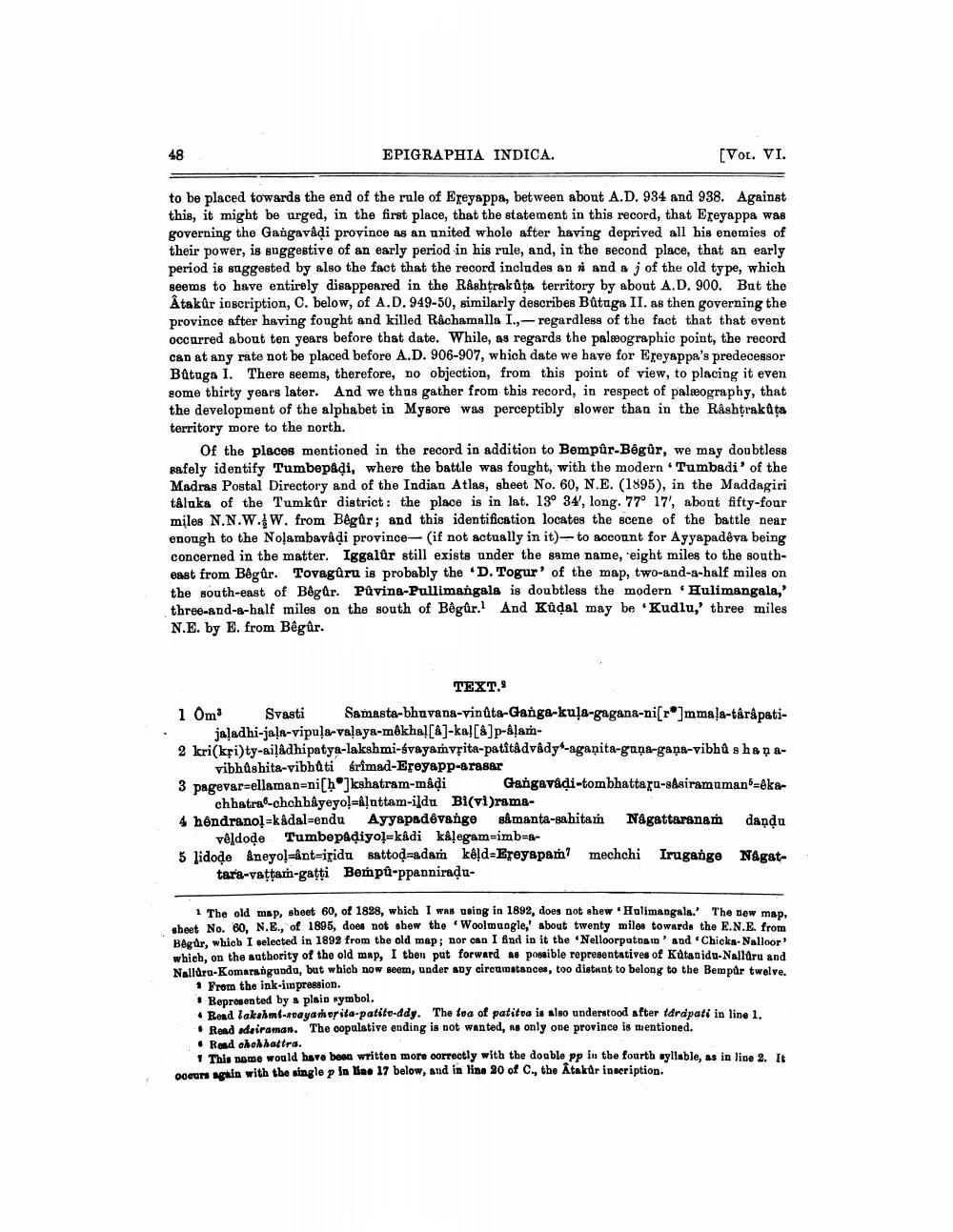________________
EPIGRAPHIA INDICA.
[VOL. VI.
to be placed towards the end of the rule of Ereyappa, between about A.D. 934 and 938. Against this, it might be urged, in the first place, that the statement in this record, that Ereyappa was governing the Gangavådi province as an united whole after having deprived all his enemies of their power, is suggestive of an early period in his rule, and, in the second place, that an early period is suggested by also the fact that the record includes an i and a j of the old type, which seems to have entirely disappeared in the Rashtrakata territory by about A.D. 900. But the Âtakûr inscription, C. below, of A.D. 949-50, similarly describes Bûtaga II. as then governing the province after having fought and killed Rachamalla I.,- regardless of the fact that that event occurred about ten years before that date. While, as regards the paleographic point, the record Cap at any rate not be placed before A.D. 906-907, which date we have for Ereyappa's predecessor Båtaga I. There seems, therefore, no objection, from this point of view, to placing it even some thirty years later. And we thus gather from this record, in respect of palæography, that the development of the alphabet in Mysore was perceptibly slower than in the Rashtrakita territory more to the north.
Of the places mentioned in the record in addition to Bempûr-Bégûr, we may doubtless safely identify Tumbepadi, where the battle was fought, with the modern . Tumbadi' of the Madras Postal Directory and of the Indian Atlas, sheet No. 60, N.E. (1895), in the Maddagiri tâluka of the Tumkur district: the place is in lat. 13° 34', long. 77° 17', about fifty-four miles N.N.W. W. from Begür; and this identification locates the scene of the battle near enough to the No!ambavadi province - (if not actually in it)- to account for Ayyapadêva being concerned in the matter. Iggalûr still exists under the same name, 'eight miles to the southeast from Bêgûr. Tovaguru is probably the 'D. Togur' of the map, two-and-a-half miles on the south-east of Bégar. Püvina-Pullimangala is doubtless the modern Hulimangala,' three-and-a-half miles on the south of Bégûr. And Kûdal may be Kudlu,' three miles N.E. by E. from Bêgûr.
TEXT. 1 Om Svasti Samasta-bhuvana-vinûta-Ganga-kuļa-gagana-ni[ro]mmaļa-tårápati
jaladhi-ja!a-vipula-valaya-mókhal[&]-ka[]p-alam2 kri(kri)ty-ailAdhipatya-lakshmi-svayamvfita-patità dvady-aganita-guna-gana-vibh û s ha na
vibhûshita-vibhàti srimad-Eroyapp-eraser 3 pagevar-ellaman=ni[h]kshatram-madi Gangavadi-tombhattaru-sAsiramuman=ka
chhatral-chchbâyeyo!=A!uttam-ildu Bi(vi)rama4 hendranol-kadal=endu Ayyapadevange såmanta-sahitam Nagattaranam dandu
veldode Tumbepadiyol=kadi kalegamwimb=&5 lidode Aneyol-antripidu Battodeadar ke?d=Ereyapam? mechchi Irugange Nagat
tara-vattam-gatti Bempu-ppanniradu
1 The old map, sheet 60, of 1828, which I was using in 1892, does not shew Hulimangala.' The new map, sheet No. 60, N.E, of 1895, does not show the 'Woolmangle,' about twenty miles towards the E.N.E. from BAG, whicb I selected in 1892 from the old map; nor can I find in it the 'Nelloorputnam' and Chicka-Nalloor whicb, on the authority of the old map, I then put forward as possible representatives of Katanidu-Nalluru and Nalluru-Komarangandu, but which now seem, under any circumstances, too distant to belong to the Bempur twelve.
• From the ink_impression. • Represented by a plain symbol. • Rond lakshmi-xvayamorita-patito-ddy. The tea of patitra is also understood after Idrdpati in line 1.
Rendadeiraman. The copulative ending is not wanted, As only one province is mentioned. Rend ohohhattra.
This name would have been written more correctly with the double pp in the fourth syllable, as in line 2. It coeurs gain with the single p In lao 17 below, and in line 20 of C., the Atakar inseription.




